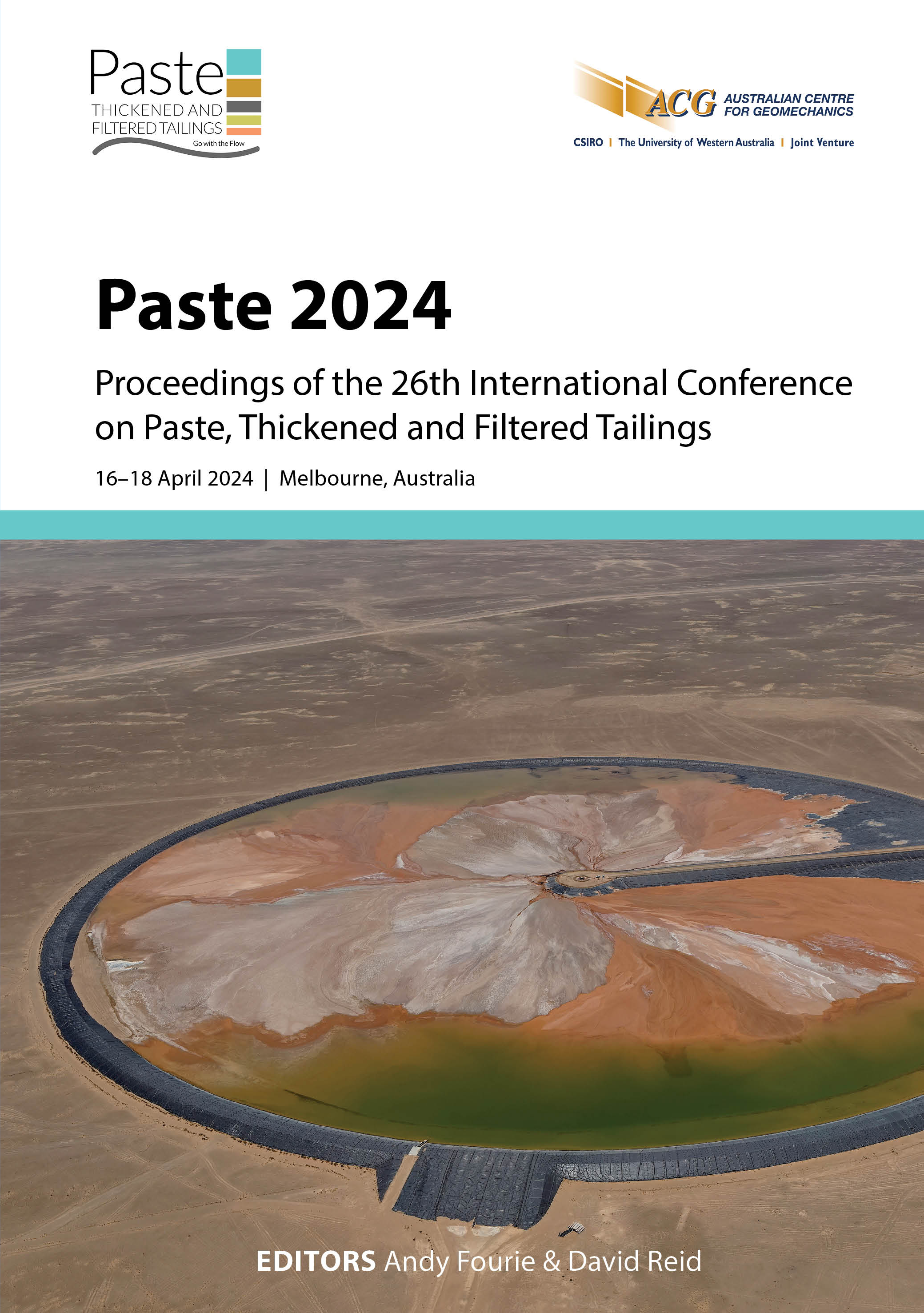Enabling sustainability in mining case study: mine backfill

|
Authors: Aguilar Sánchez, I; Bellver Baca, MT; Barahona, W; Arcila-Gut, S; Erismann, F; Avilés, E; Weinkauf, A; Hansson, M; Contador, R |
DOI https://doi.org/10.36487/ACG_repo/2455_30
Cite As:
Aguilar Sánchez, I, Bellver Baca, MT, Barahona, W, Arcila-Gut, S, Erismann, F, Avilés, E, Weinkauf, A, Hansson, M & Contador, R 2024, 'Enabling sustainability in mining case study: mine backfill', in AB Fourie & D Reid (eds), Paste 2024: Proceedings of the 26th International Conference on Paste, Thickened and Filtered Tailings, Australian Centre for Geomechanics, Perth, pp. 373-384, https://doi.org/10.36487/ACG_repo/2455_30
Abstract:
Mine tailings are the byproduct of the extraction process and they represent a byproduct whose storage is expensive and, in many cases, a reason of environmental concern. As a result, tailings storage must be planned and carefully executed, monitoring changes even after the mine closure. The rising need in resources worldwide is being accompanied by a progressive decrease in commodity grades per tonne. That means that more material must be extracted and processed to obtain the same amount of commodity (e.g. Au, Cu, Ag etc.). As a consequence, the amount of tailings generated is expected to increase with time, and the correct management of this ‘waste’ material is a growing concern for the mining business. Due to the progressive global shift towards underground mining, mine backfill (MBF) practices are becoming a frequent must in flow sheets. MBF reduces the amount of tailings stored on surface by placing them underground together with water and cement, with the aim to fill the voids. This procedure also allows miners to extract material nearby without compromising global stability (avoiding other issues such as subsidence). To achieve this goal, the hardened paste must comply with strict strength requirements which are normally achieved by increasing the amount of cement in the mix. In the race to net zero many mines have signed strict environmental policies, which compromise the cost balance of any process using cement, including MBF. This compels the businesses to utilise chemicals that reduce the amount of binder, and therefore the carbon footprint, while improving the performance of the mix at all stages. The Sika® multinational brand provides tailor-made reliable and sustainable chemical solutions to many industries, including the mining business. The application of Sika technologies and know-how supports more sustainable procedures and greener (and more profitable) practices. Each mine has different mineralogy, which makes every project unique. Finding the right cement and admixture can therefore be a time-consuming task, which directly affects the profitability of the mine, especially during field testing manoeuvres. As such, the development of tools and techniques which shorten the time between testing and decision-making are crucial to resume exploitation fast. In this work, the authors successfully apply a tailor-made MBF technology to reduce cement (and the associated CO2 footprint) in an underground gold mining project, and propose a three-dimensional quickview plot design. In this kind of graph, different field tests analyses are displayed, allowing the viewer to simultaneously compare strength, cement percentages and admixture dosages for a given time (e.g. 3, 7, 28 days). This view enhances the understanding of the system as a whole, allowing for an easy assessment of the changing properties of the hardened paste when the cement and admixture percentages vary, helping in decision-making.
Keywords: cemented paste backfill, mining, cement reduction, time management, data plot
References:
Borrego-Sánchez, A & Sainz-Díaz, CI 2022, ‘Clay minerals as filters of drug compounds for green chemistry applications’, Green Chemistry and Computational Chemistry, pp. 403–423.
Deb, D, Dey, GK & Panchal, S 2017, ‘Paste backfill technology: essential characteristics and assessment of its application for mill rejects of uranium ores’, Transactions of the Indian Institute of Metals, vol. 70, pp. 487–495.
Dikonda, RK, Mbonimpa, M & Belem, T 2021, ‘Specific mixing energy of cemented paste backfill, Part I: Laboratory determination and influence on the consistency’, Minerals, vol. 11, no. 11, p. 1165.
Grabinsky, MW, Thompson, BD & Veenstra, RL 2023. ‘Cemented paste backfill strength profiles for continuous pouring and liquefaction resistance’, in GW Wilson, NA Beier, DC Sego, AB Fourie & D Reid (eds), Paste 2023: Proceedings of the 25th International Conference on Paste, Thickened and Filtered Tailings, University of Alberta, Edmonton, and Australian Centre for Geomechanics, Perth, pp. 257–270.
Gruszczyński, M, Czaban, S, Pratkowiecki, R, Skrzypczak, Z & Stefanek, P 2021, ‘The influence of the flocculant on the process of thickening and depositing of copper ore flotation tailings’, in F Hassani, J Palarski, V Sokola-Szewiola & G Strozik (eds), Minefill 2020-2021: Proceedings of the 13th International Symposium on Mining with Backfill, CRC Press, Routledge.
Li, W & Fall, M 2016, ‘Sulphate effect on the early age strength and self-desiccation of cemented paste backfill’, Construction and Building Materials, vol. 106, pp. 296–304.
Marghany, M 2021, ‘Advanced Algorithms for mineral and hydrocarbon exploration using synthetic aperture radar’, Elsevier, pp. 31–79.
Ndlovu, B, Becker, M, Deglon, D & Franzidis, JP 2011, ‘The influence of phyllosilicate mineralogy on the rheology of mineral slurries’, Minerals Engineering, vol. 24, no. 12, pp. 1314–1322.
Slade, NM 2010, ‘Paste backfill — adding value to underground mining’, in R Jewell & AB Fourie (eds), Paste 2010: Proceedings of the Thirteenth International Seminar on Paste and Thickened Tailings, Australian Centre for Geomechanics, Perth, pp. 99–109,
© Copyright 2025, Australian Centre for Geomechanics (ACG), The University of Western Australia. All rights reserved.
View copyright/legal information
Please direct any queries or error reports to repository-acg@uwa.edu.au
View copyright/legal information
Please direct any queries or error reports to repository-acg@uwa.edu.au
